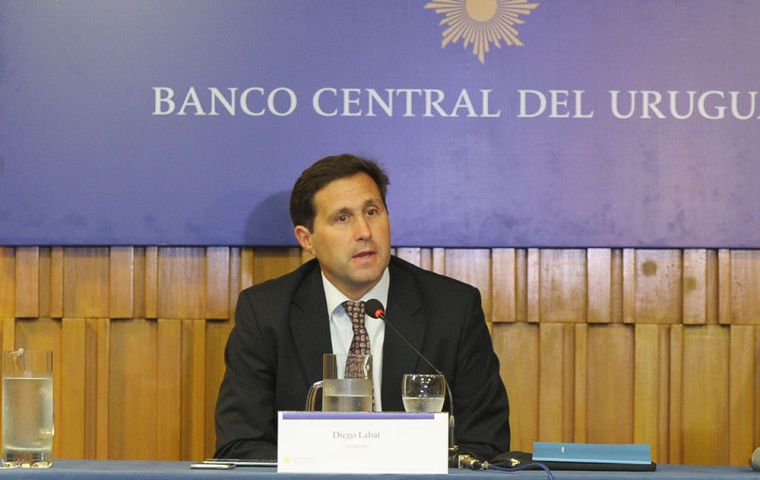MercoPress. South Atlantic News Agency
Uruguay's Central Bank concerned about growth projections for 2021 in coronavirus context
 “We are continuously analyzing it and today our best projection is 3.5%,” Labat said.
“We are continuously analyzing it and today our best projection is 3.5%,” Labat said. Uruguay's Central Bank Friday released its report for the first quarter of 2021 which highlighted the entity's concern regarding “three relevant risks” in a growth scenario of just 3.5% this year.
The report stated that ”the baseline scenario (...) supposes a recovery in the monetary policy horizon“ and ”in this framework, the economy would grow 3.5% annual average in 2021 (same projection as the Ministry of Economy and Finance) and 3.1% annual average in 2022.“
But despite the assertions, the report warned that the figures ”continue to be quite uncertain, which is reflected in the greater width of the confidence interval” after the the Gross Domestic Product (GDP) fell 5.9% in 2020.
BCU President Diego Labat said regarding whether this projection is going to be modified that “we are continuously analyzing it and today our best projection is 3.5%.” He added that “the risk map reflects our concern about the coronavirus and how long these health emergency effects last.”
Meanwhile, BCU Vice President Washington Ribeiro explained that “the tourist season was bad and it did not take us by surprise” since it was foreseen in the previous report, in reference to the BCU's Monetary Policy Committee (Copom) from March 26 regarding the total opening of the economy in the third quarter when herd immunity against COVID-19 will have been achieved.
And BCU Monetary Policy Area Manager Leonardo Vicente pointed out that this was the information available prior to the Copom and that “what was not in the base scenario is the resurgence of contagions. We don't know how it will evolve ”.
The new report singles out “three relevant risks” for the base scenario of growth of 3.5% this year: “the loss of investment grade, the misalignment of inflation expectations with respect to the target range and an expansion of the coronavirus beyond what was expected.”
”Regarding risk 1 (loss of investment grade), it is assigned a low probability of occurrence,“ the report indicated, as a result of government measures to gradually reduce the fiscal deficit. Then, about the ”misalignment of inflation expectations with respect to the target range (risk 2), it has been observed that agents' expectations have remained outside the range, exhibiting downward rigidity“, for which merited a ”medium-low“ risk of occurrence.
But ”the expansion of the coronavirus at the domestic level (risk 3) is identified as a risk with a potential impact on medium-high activity,“ and should ”the rate of infections continue to accelerate, new measures to restrict mobility could be necessary, affecting the supply and / or demand of various activities. On the other hand, this risk can be mitigated by the rapid expansion of the vaccination process, which would lead to lower levels of infections and deaths in the coming weeks,“ the BCU added.
The downward trend was reversed in March with the recovery of areas such as exports, imports of capital and energy goods, and public consumption indexes, the BCU report explained. Agriculture and the manufacturing industry were among the first to bounce back, while commerce and services lag further behind, it added.
Other areas to grow rapidly were telecommunications, due to the intensive use of data during the pandemic, and construction, due to the start of works related to the central railway and UPM II...,” the report went on.
The BCU document also foresees that “during 2021 growth will be driven by the recovery of exports and private investment, which includes investment related to the pulp mill” and that “exports would continue to contribute to the expansion of GDP in 2022, to which is added the growth of private consumption.”
“There is still a high level of uncertainty in the future evolution of GDP, associated with the speed and magnitude of the recovery after the shock linked to the pandemic,” the report finally admitted.
Data for the first quarter of GDP will be released in June, however the BCU uses “high-frequency leading indicators” to analyze how the economy is doing.




Top Comments
Disclaimer & comment rulesCommenting for this story is now closed.
If you have a Facebook account, become a fan and comment on our Facebook Page!